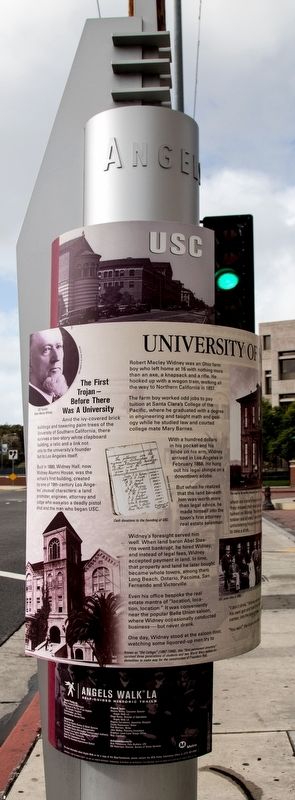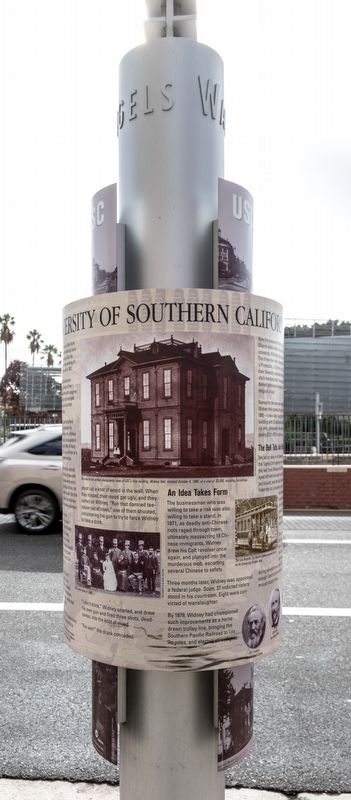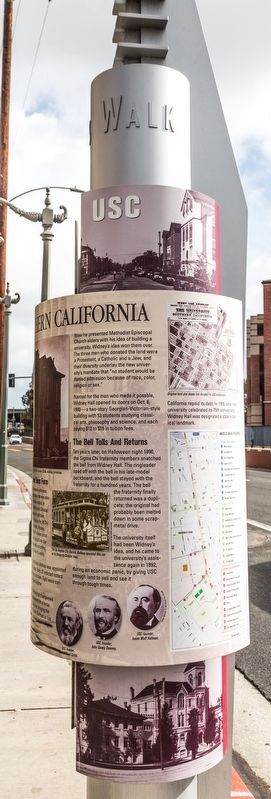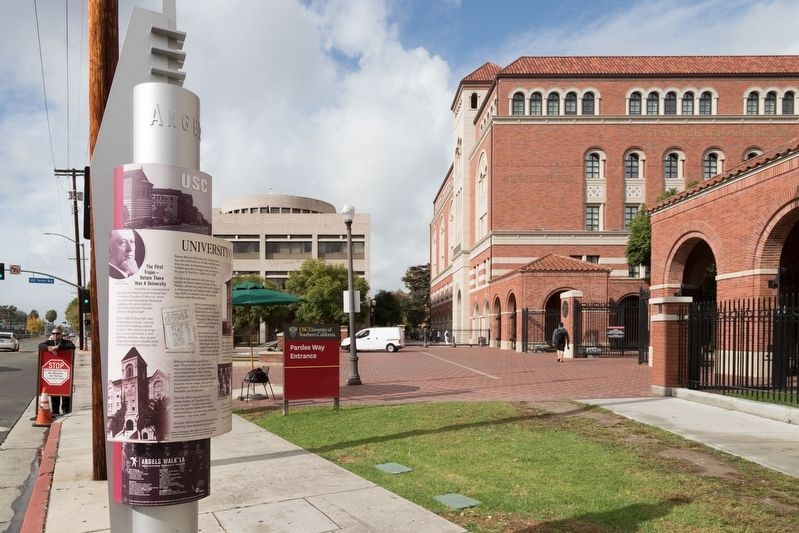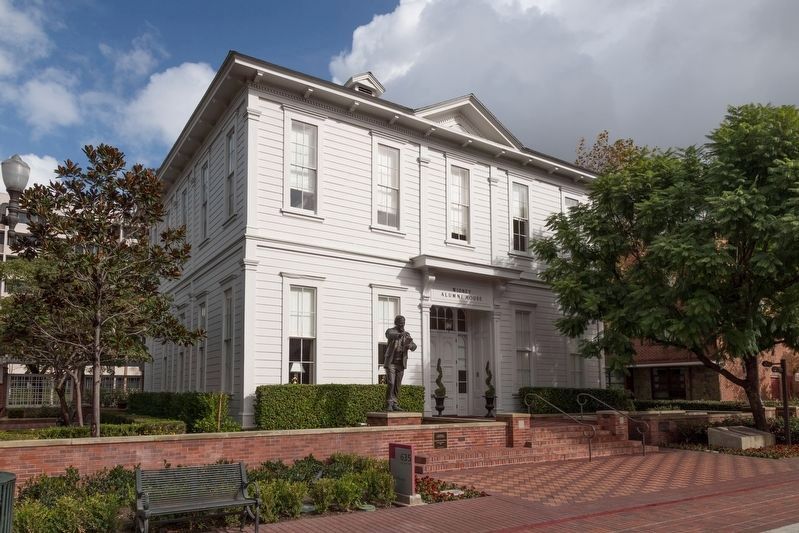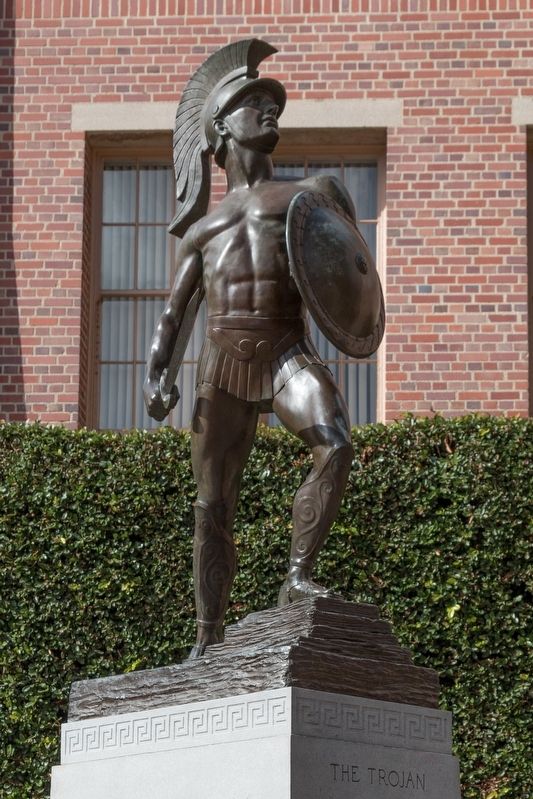South Los Angeles in Los Angeles County, California — The American West (Pacific Coastal)
University of Southern California
Widney Hall
— USC —
The First Trojan—Before There Was A University
Amid the ivy-covered brick buildings and towering palm trees of the University of Southern California, there survives a two-story white clapboard building, a relic and a link not only to the university's founder but to Los Angeles itself.
Built in 1880, Widney Hall, now Widney Alumni House, was the school’s first building, created by one of 19th-century Los Angeles’ unusual characters: a land promoter, engineer, attorney and judge who was also a deadly pistol shot and the man who began USC.
Robert Maclay Widney was an Ohio farm boy who left home at 16 with nothing more than an axe, a knapsack and a rifle. He hooked up with a wagon train, walking all the way to Northern California in 1857.
The farm boy worked odd jobs to pay tuition at Santa Clara’s College of the Pacific, where he graduated with a degree in engineering and taught math and geology while he studied law and courted college mate Mary Barnes.
With a hundred dollars in his pocket and his bride on his arm, Widney arrived in Los Angeles in February 1868. He hung out his legal shingle on a downtown adobe.
But when he realized that the land beneath him was worth more than legal advice, he made himself into the town’s first attorney-real estate salesman.
Widney’s foresight served him well. When land baron Abel Stearns went bankrupt, he hired Widney, and instead of legal fees, Widney accepted payment in land. In time, that property and land he later bough became whole towns, among them Long Beach, Ontario, Pacoima, San Fernando and Victorville.
Even his office bespoke the real estate mantra of “location, location, location.” It was conveniently near the popular Bella Union saloon, where Widney ocassionally conducted business—but never drank.
One day, Widney stood at the saloon door, watching some liquored-up men try shoot out a knot of wood in the wall. When they missed, their mood got ugly, and they turned on Widney. “Run that damned teetotaler out of town,” one of them shouted, unholstering his gun to try to force Widney to take a drink.
“I don’t drink,” Widney snarled, and drew his own gun and fired three shots, dead-center, into the knot of wood.
“You win!” the drunk conceded.
An Idea Takes Form
The businessman who was willing to take a risk was also willing to take a stand. In 1871, as deadly anti-Chinese riots raged through town, ultimately massacring 18 Chinese immigrants, Widney drew his Colt revolver once again, and plunged into the murderous mob, escorting several Chinese to safety.
Three months later, Widney was appointed a federal judge. Soon, 37 indicted rioters stood in his courtroom. Eight were convicted of manslaughter.
By 1879, Widney had championed such improvements as a horse-drawn trolley line, bringing the Southern Pacific Railroad to Los Angeles, and electric streetlights.
Now he presented Methodist Episcopal Church elders with his idea of building a university. Widney’s idea won them over. The three men who donated the land were a Protestant, a Catholic and a Jew, and their diversity underlay the new university’s mandate that “no student would be denied admission because of race, color, religion or sex.”
Named for the man who made it possible, Widney Hall opened its doors on Oct. 6, 1880—a two-story Georgian-Victorian-style building with 53 students studying classical arts, philosophy and science, and each paying $12 to $15 in tuition fees.
The Bell Tolls And Returns
Ten years later, on Halloween night 1890, the Sigma Chi fraternity members snatched the bell from Widney Hall. The ringleader sped off with the bell in his late-model buckboard, and the bell stayed with the fraternity for a hundred years. The bell the fraternity finally returned was a duplicate; the original had probably been melted down in some scrap-metal drive.
The university itself had been Widney’s idea, and he came to the university’s assistance again in 1892, during an economic panic, by giving USC enough land to sell to see it through tough times. California repaid its debt. In 1955, when the university celebrated its 75th anniversary, Widney Hall was designated a state historical landmark.
Erected 2005 by City of Los Angeles.
Topics. This historical marker is listed in this topic list: Education. A significant historical month for this entry is February 1868.
Location. 34° 1.102′ N, 118° 16.995′ W. Marker is in Los Angeles, California, in Los Angeles County. It is in South Los Angeles. Marker is at the intersection of Exposition Boulevard and Pardee Way, on the right when traveling west on Exposition Boulevard. Touch for map. Marker is in this post office area: Los Angeles CA 90089, United States of America. Touch for directions.
Other nearby markers. At least 8 other markers are within walking distance of this marker. A Trojan for Life (about 400 feet away, measured in a direct line); The Oldest University Building in Southern California (about 400 feet away); Town and Gown of USC (about 500 feet away); John C. Argue Plaza (about 500 feet away); Petrified Tree from the Arizona Forest (about 500 feet away); USC Urban Legends (about 500 feet away); Endowing the Future (about 600 feet away); California Science Center (about 600 feet away). Touch for a list and map of all markers in Los Angeles.
More about this marker. This historical interpretive
panel has a number of illustrations (from top to bottom, left to right): “USC founder Robert Maclay Widney.” • “Known as ‘Old College’ (1887-1948), this ‘first permanent structure’ survived three generations of students and two World Wars before its demolition to make way for the construction of Founders Hall.” • A ledger showing “Cash donations to the founding of USC.” • This may be the earliest photographic view of USC’s first building, Widney Hall, finished October 4, 1880, at a cost of $5,060, including furnishings.” • “The Los Angeles City Electric Railway operated this car on its University Division lines.” • “USC founder, Ozro William Childs.” • “USC founder, John Gately Downey.” • USC founder, Isaias Wolf Hellman.” &bull “Original land plot shows lots donated for USC endowment.” • A map of Angels Walk historical markers.
Also see . . .
1. Angels Walk L.A. Self-guided walking tours of historic neighborhoods in Los Angeles. The USC marker is part of the Figueroa walk. (Submitted on January 14, 2019.)
2. About USC. University website homepage (Submitted on January 9, 2019.)
Additional keywords. terrorism
Credits. This page was last revised on December 18, 2023. It was originally submitted on January 9, 2019, by J. J. Prats of Powell, Ohio. This page has been viewed 464 times since then and 34 times this year. Last updated on January 14, 2019, by Craig Baker of Sylmar, California. Photos: 1, 2, 3, 4. submitted on January 9, 2019, by J. J. Prats of Powell, Ohio. 5. submitted on November 29, 2018, by J. J. Prats of Powell, Ohio. 6. submitted on January 9, 2019, by J. J. Prats of Powell, Ohio. • Andrew Ruppenstein was the editor who published this page.
